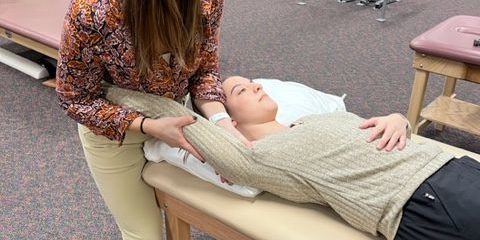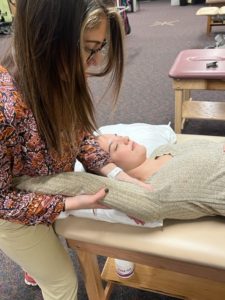
Are you having shoulder pain? Do you feel like you are losing the ability to reach up or overhead? If so, then you may be experiencing symptoms of a condition called Frozen Shoulder. Frozen Shoulder, or known medically as Adhesive Capsulitis, affects 2% of the population and can result from viral illness or prolonged immobilization. Although frozen shoulder predominantly affects women over the age of 40, as well as those with Diabetes, it is not exclusive to these populations. If these symptoms sound familiar, reach out to your physical therapist or healthcare provider.
So what is Frozen Shoulder?
As the name suggests, this condition is based on a few key symptoms including stiffness and pain. Frozen shoulder is a progressive condition, meaning that it gets worse over time. However, depending on how early the symptoms are diagnosed, and how quickly physical therapy is implemented, Frozen Shoulder can last as short as 2-3 months, or as long as years. Individuals with this condition will experience the following stages.
1. The Freezing Stage: This is the first stage of frozen shoulder and the most painful stage. At this stage, range of motion is only minimally affected, and pain occurs with shoulder movement. Oftentimes during this stage, a cortisone shot is utilized to help with pain and to improve tolerance to PT. This phase can feel more like a rotator cuff tendinitis or bursitis since motion isn’t greatly affected yet. A person can remain in this stage for months before moving into the second stage.
2. The Frozen Stage: During this stage, the pain experienced in the previous stage has improved, but the range of motion in the shoulder has worsened. At this point, the shoulder joint experiences capsular fibrosis which is the cause for severe motion limitations. Because movement is difficult, patients often rely on the opposite limb to do everyday activities. This stage can be frustrating because improvements in range of motion are difficult to obtain. Fortunately, with the help of physical therapy, range of motion can be restored quicker and the progression to the third stage can occur earlier.
3. The Thawing Stage: This occurs as the patient’s range of motions slowly returns. They may experience increased pain in the beginning of this stage, but as motion returns, they feel their shoulder returning to normal.
What are the signs of Frozen Shoulder?
Symptoms of this condition present as joint motion restrictions and pain. For frozen shoulder, joint limitations are defined by losses in the ability to reach behind your head, reach overhead, reach out to the side, and/or reach behind your back. Examples of functional movements that are affected are retrieving your wallet from your back pocket, reaching to put your seatbelt on, reaching into cabinets, or reaching up to wash/style your hair, among others. If these motions are currently bothering you, talk to your healthcare provider.
What should I do if I think I have frozen shoulder?
If you think you are experiencing the signs and symptoms of frozen shoulder, it’s always beneficial to seek out a healthcare professional. Physical therapists can diagnose this condition and refer patients to orthopedic specialists if necessary.
I have Frozen Shoulder; how do I fix it?
Once you have talked to your healthcare provider, there are treatment options available. Physicians can administer injections to the shoulder to decrease inflammation in the joint. This can provide short term pain relief. Physicians oftentimes prescribe physical therapy to speed up the healing process. Physical therapists are trained to treat the symptoms of frozen shoulder and will create a custom plan that fits your needs and goals. You will see your Physical Therapist 2-3 times a week for 8-12 weeks depending on the severity of symptoms.
Overall, Frozen Shoulder can be a challenging condition. However, with the right resources and support from your physical therapists at University Physical Therapy, you can get back to a good quality of life.
